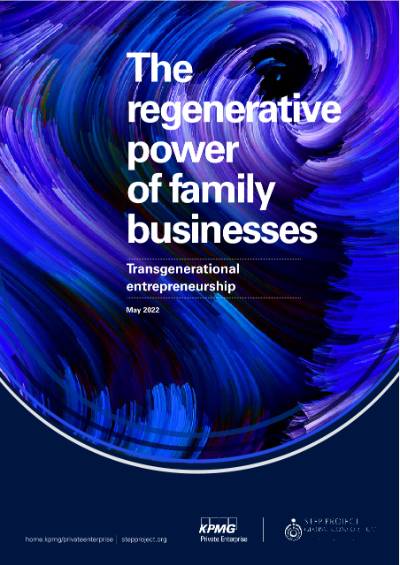What is it about family businesses that enables them to stay ahead of the competition? What is the secret to their staying power and their capacity to grow successfully from decade to decade and from generation to generation?
The STEP Project Global Consortium and KPMG Private Enterprise came together to explore the reasons behind this “regenerative superpower” of family businesses. The regenerative power of family businesses: Transgenerational entrepreneurship Global report was developed using the survey data collected from 2,439 family business leaders across 70 countries and territories worldwide, including Canada.
The report highlights how a strong entrepreneurial orientation, emotional attachment to the family business, and the ability of next-gens to take risks are critical elements of future business success.
The report found that the main keys family businesses are using to unlock their regenerative abilities are:
- Entrepreneurial orientation: The importance of keeping the founder’s entrepreneurial spirit alive is a major contributor to a continuous innovation mindset. Potential next-generation successors are being educated on how to take calculated and responsible risks and make judgments on their own, with small amounts of family capital enabling them to learn from firsthand experiences.
- Socioemotional wealth: The family’s control and influence allows for quick decision making, and their “socioemotional wealth” is viewed as an essential endowment — one that the family values and protects. For many of the respondents, this is a measure of performance beyond financial wealth and one that is often difficult to replicate in non-family businesses.
- Motivational leadership: Entrepreneurialism and socioemotional wealth go hand-in-hand as competitive differentiators, further strengthened by the impact of a transformational or charismatic leader.
The way forward
Research shows that the family business model is the best performing model across the globe. However, the challenge for family businesses and especially their next-generation leaders is to find a way to manage the paradox of tradition and change.

Based on the survey findings, there is fresh leadership potential among young Millennials who are stepping forward – including a higher proportion of women family members.
A diversity of views, talents, and experiences has tremendous power in helping to lead their companies forward in new and interesting directions.
Entrepreneurial orientation
The entrepreneurial mindset originated by the founder, combined with the family’s resources and capabilities, is what leads to the “transgenerational entrepreneurship” capability of family businesses.
Changing demographics as well as the scale of a business’s operations can both impact a company’s entrepreneurial orientation. However, in taking a closer look at the entrepreneurial orientation of family businesses, we found three main dimensions: innovativeness, proactiveness and risk-taking.
In Canada, the entrepreneurial orientation steered more towards a risk-taking mindset so when there are disruptive technologies, industry changes or changes to the needs of the family there is a stronger likelihood to adopt.
Entrepreneurial risk-taking is typically more prevalent with younger CEOs as they are less risk averse and more aggressive in growing their businesses to ensure they outperform their competition.

Beyond financial wealth
In addition to the importance of a family business’s entrepreneurial orientation, a second critical component of transgenerational entrepreneurship is the family’s socioeconomic wealth – the emotional value they derive from owning and managing the business.
It reflects the unique ways in which families look at problems and how their actions might affect three important characteristics used to measure their socioeconomic wealth: the family’s control and influence, their emotional attachment and identification with the family business.

Maintaining family control is often a priority to help ensure the sustainability of the core business through slow and steady growth.
Families are continuously reinvesting in their businesses, and when potential new partnerships are being evaluated, the family needs to make sure their partners have the same long-term views and values. For this reason, maintaining control is often a key driver for many family businesses.
One of our primary goals in developing this report was to provide leaders of family businesses — and their families — with an array of examples and actions that others around the globe have taken under similar circumstances to make sure they’re continuously reinvigorated and growing. We believe this regenerative capability is the superpower of family businesses.
Explore the report to learn more about what this means for your family business, how you can continue to build on your strengths that already exist, as well as the pragmatic actions you might consider to fill some potential gaps.
Insights and resources
Connect with us
Stay up to date with what matters to you
Gain access to personalized content based on your interests by signing up today
Connect with us
- Find office locations kpmg.findOfficeLocations
- kpmg.emailUs
- Social media @ KPMG kpmg.socialMedia







